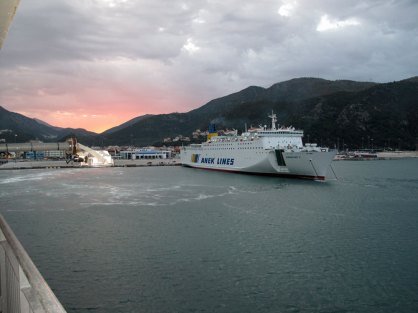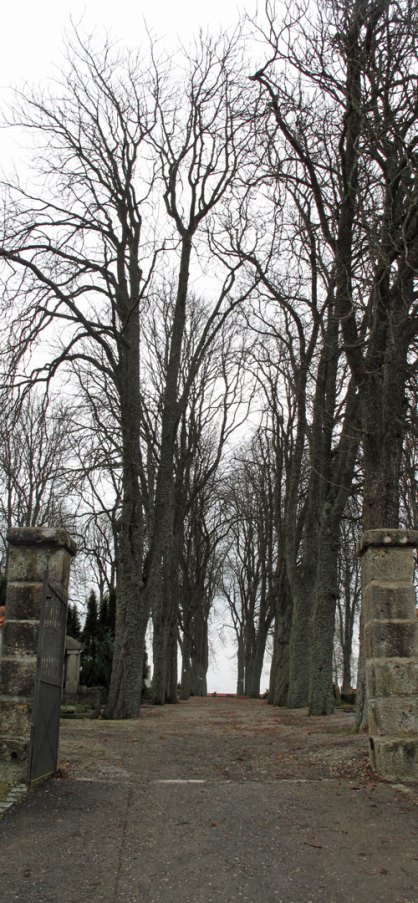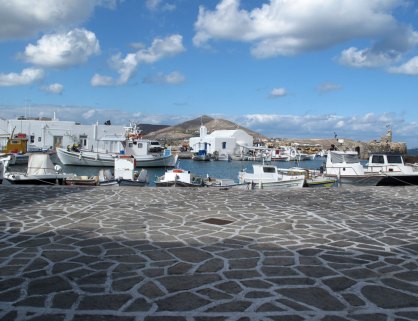
Time present and time past
Are both perhaps present in time future,
And time future contained in time past.
If all time is eternally present
All time is unredeemable.

Ο παρων και ο παρελθων χρονος
Ισως ειναι κι οι δυο παροντες σε χρονο μελλοντικο,
Και ο μελλοντικος χρονος εμπεριεχεται σε χρονο παρελθοντα.
Αν ολος ο χρονος ειναι παντοτινα παρων
Ολος ο χρονος ειναι χωρις λυτρωμο.
(Η αποδοση στα ελληνικα ειναι δικη μου)
Burnt Norton, Four Quartets, T S Eliot

Introduction
Theo Angelopoulos died in a accident on 24 January 2012. He was a Greek film director, producer and screenwriter.
Ο Θοδωρος Αγγελοπουλος πεθανε σε τροχαιο ατυχημα την 24η Ιανουαριου 2012. Ηταν σκηνοθετης, παραγωγος και σεναριογραφος.
As it happens with every great filmmaker, a lot has been written and said about Angelopoulos. Most of it is stereotypical and cliche, which Angelopoulos himself hated. As an example, I site his “left wing” ideology, that he was the filmmaker of the “defeated” side in the Greek civil war of 1944-1949. In addition, a lot has been written regarding Angelopoulos’ “sequence-shot”, which imposes huge demands on the spectator, almost forcing him to delve into the image and its slow motion. Angelopoulos is notoriously difficult, but pays off handsomely the brave ones who can stand their ground in front of the ocean of slow images the director throws at them.
Όπως συμβαινει με καθε μεγαλο σκηνοθετη, εχουν ειπωθει και γραφτει πολλα για τον Αγγελοπουλο. Και τα περισσοτερα απο αυτα ειναι κλισε και στερεοτυπα που ο ιδιος ο Αγγελοπουλος απεχθανοταν. Αναφερω για παραδειγμα το οτι ηταν αριστερος, το οτι εκανε κινηματογραφο για τους ηττημενους. Επισης πολλα απο τα γραφεντα και γραφομενα εχουν να κανουν με τα παροιμιωδη πλανα-σεκανς του Αγγελοπουλου, που απαιτουν απο τον θεατη να εντρυφησει στα οσα βλεπει. Ο Αγγελοπουλος ειναι πολυ δυσκολος αλλα ανταμοιβει πλουσιοπαροχα οσους αντεξουν.
In his artistic development and path Angelopoulos followed a helix curve. Its description requires a separate article and I will not do it today. Today I want to focus on Angelopoulos’ treatment of time, a recurrent and self-standing topic in his movies.
Στην καλλιτεχνικη του διαδρομη ο Αγγελοπουλος ακολουθησε μια ελικοειδη πορεια. Και μονο η περιγραφη της απαιτει ενα ξεχωριστο αρθρο. Δεν ειναι αυτη η προθεση μου σημερα. Σημερα θελω να εστιασω στον τροπο με τον οποιο ο Αγγελοπουλος χειριστηκε τον Χρονο, που ειναι ενα συνεχως αναδυομενο και αυτοτελες θεμα στις ταινιες του Αγγελοπουλου,

Part I: The sequence shot
Μερος 1ο: Το πλανο-σεκανς
“The past is never dead. It’s not even past”
Το παρελθόν δεν είναι ποτέ νεκρό. ∆εν έχει καν παρέλθει.
Requiem for a Nun, William Faulkner
The sequence shot is one of the trademarks of Angelopoulos and a major tool in his treatment of time in his films.
“The sequence shot offers, as far as I’m concerned, much more freedom,” Angelopoulos explained. “By refusing to cut in the middle, I invite the spectator to better analyse the image I show him, and to focus, time and again, on the elements that he feels are the most significant in it.” (The Guardian)
Το πλανο-σεκανς ειναι απο τα ιδιαιτερα χαρακτηριστικα του Αγγελοπουλου και σφραγιζει την διαχειριση του χρονου στις ταινιες του.
Σε αρθρο της βρεταννικης εφημεριας “Γκαρντιαν” διαβαζουμε τη σχετικη αναφορα – δηλωση του Αγγελοπουλου: “Το πλανο-σεκανς κατα τη γνωμη μου σου δινει πολυ περισσοτερη ελευθερια. Αρνουμενος να το κοψω στη μεση, προσκλαω τον θεατη να αναλυσει καλυτερα την εικονα που του δειχνω, και να εστιασει ξανα και ξανα στα στοιχεια εκεινα που αισθανεται οτι ειναι τα πιο σημαντικα μεσα σε αυτο.”

David Jenkins in his BFI article, helps us with the way Angelopoulos is deploying the “sequence shot”:
“His stock-in-trade is the immaculately choreographed sequence shot in which his camera lopes ominously and gracefully across landscapes, through rooms, shacks, courtyards, over and around huddled crowds of people who themselves produce artful formations as they mingle within the frame. His colossal geopolitical masterwork from 1975, The Travelling Players (O thiassos), offers just 80 separate shots during its four-hour running time. History, catastrophes, celebrations, political intrigues, social shifts are rarely recounted in the traditional linear sense – rather, they are daubed on to a vast and elaborate narrative fresco.”

Ο Ντειβιντ Τζενκινς σε αρθρο του στον ιστοχωρο του Βρεταννικου Κινηματογραφικου Ινστιτουτου αναπτυσσει τον τροπο με τον οποιο ο Αγγελοπουλος χρησιμοποιησε το πλανο-σεκανς στις ταινιες του.
“Το σημα κατατεθεν του ειναι το αψογα χορογραφημενο πλανο-σεκανς, στο οποιο η καμερα του με χαρη αλλα και απειλη δρασκελιζει νωχελικα τοπια, δωματια, καλυβες, αυλες, περιτριγυριζει συνωστισμενα πληθη πουαναπτυσσονται σε καλλιτεχνικα σχηματα καθως εμπλεκονται στο πλανο. Η κολοσσιαια γεωπολιτικη δημιουργια του απο το 1975, ο Θιασος, προσφερει μολις 80 διαφορετικες ληψεις στη διαρκεια των τεσσαρων ωρων της. Η Ιστορια, οι καταστροφες, οι γιορτες, οι πολιτικες συνομωσιες, οι κοινωνικες μεταλλαξεις, σχεδον ποτε δεν παρουσιαζονται με γραμμικο τροπο, αλλα στιβαζονται στον τεραστιο και περιπλοκο αφηγηματικο καμβα του Αγγελοπουλου.”
Part II: Beyond technique
Μερος 2ο: Το επεκεινα της τεχνικης
“Αιών παις εστί παίζων πεσσεύων”
Time is a child playing dice
Ο χρονος ειναι ενα παιδι που παιζει ζαρια
Heracletus, Ηρακλειτος

Barthélémy Amengual notes in his essay “The poetics of History”:
“History dictates to the filmmaker his two major themes: time and remembrance. Time is the body and the place of History. Remembrance is the human form of time. Remembrance is the clerk of time, but also its palimpsest. The last shot of “Reconstruction” reproduces the first shot. The traveling players ends in 1952 at the spot where it started back in 1932: the rail station of Aegion. All the actors are there, including those who have died or left.”
Ο Barthélémy Amengual στο δοκιμιο του “Μια Ποιητικη της Ιστοριας” σημειωνει:
“Η Ιστορία υπαγορεύει στον κινηµατογραφιστή τα δύο µεγάλα του θέµατα: το χρόνο και τη/τις µνήµη/ες. O χρόνος είναι το σώµα και ο τόπος της Ιστορίας· η µνήµη, η ανθρώπινη µορφή του χρόνου. Η µνήµη είναι ο γραµµατικός του χρόνου,
µα και το παλίµψηστό του. Το τελευταίο πλάνο της Αναπαράστασης αναπαράγει το πρώτο. O θίασος ολοκληρώνεται το 1952 εκεί όπου είχε αρχίσει, το 1932: στον σιδηροδροµικό σταθµό του Αιγίου. Όλοι οι ηθοποιοί είναι εκεί, ακόµα και
οι απόντες: αυτοί που έχουν πεθάνει ή αποχωρήσει.”

“In Angelopoulos’ films time, which is nothing but the bedrock of every change, manifests itself between the start and the end of the same sequence shot. If the sequence has begun with the dusk, it concludes with the dawn. Like a river, if it starts flowing from a source, it ends at a totally different place. Time stems from and flows in fornt of our eyes, as we see a rose bloom in accelerated motion. The moment (in the context of the sequence shot) extends itself; we have to wait for the sugar to dilute itself first. After a while time is transformed (in the flow of panoramic travelling shots) by acquiring Bergsonian duration and, almost in hiding it is submerged in history. The present becomes remembrance; not a frozen dot in the past, but a moving unit of becoming, a gathering of being, of the group, of the world.”
“Στον Αγγελόπουλο, ο χρόνος, που δεν είναι παρά η κοίτη κάθε αλλαγής, εκδηλώνεται µεταξύ αρχής και τέλους του ίδιου πλάνου-σεκάνς. Αν το πλάνο έχει αρχίσει σούρουπο, ολοκληρώνεται την αυγή· αν έχει αρχίσει σ’ έναν τόπο, εκβάλλει σ’ έναν εντελώς διαφορετικό· αν σε µια εποχή, καταλήγει σε µιαν άλλη. O χρόνος πηγάζει και κυλά µπροστά στα µάτια µας, όπως βλέπουµε ένα ρόδο ν’ ανθίζει µε αξελερέ. Η στιγµή (στο πλάνο-σεκάνς) παρατείνεται: πρέπει πρώτα να περιµένουµε να λιώσει η ζάχαρη· µετά από λίγο, µεταµορφώνεται (µέσα στη ροή των πανοραµικών τράβελινγκ) σε µπερξονική διάρκεια και, στα κρυφά, βυθίζεται στην Ιστορία. Το παρόν γίνεται µνήµη· όχι νεκρό παρελθόν σηµείο, αλλά κινούµενη µονάδα τού γίγνεσθαι, συνάθροιση του είναι, του ατόµου, της οµάδας, του κόσµου.”

Part III: When the cycle closes
Μερος 3ο: Οταν κλεινει ο κυκλος
The secret roar of the approaching events is coming to them (the wise men).
Η μυστική βοή τους έρχεται των πλησιαζόντων γεγονότων.
C Cavafy, Σοφοι δε προσιοντων, Κωστας Καβαφης

In “Ulysses’ Gaze”, the Greek filmmaker “A”, played by Harvey Keitel starts his journey in the Balkans in a taxi driven by Thanassis Veggos, a legendary Greek actor. When they stop to rest on a snow-covered mountain, Veggos says:
“Do you know something? Greece is dying. We die as people. We have completed our cycle. I do not know how many thousands of years in the midst of broken stones and sculptures… and we die…
But if Greece is going to die, let her die quick! Because the agony lasts very long and makes a lot of noise.”

Στην ταινια “Το Βλεμμα του Οδυσσεα”, ο Ελληνας κινηματογραφιστης “Α”, που τον υποδυεται ο Αμερικανος ηθοποιος Χαρβευ Καιτελ ξεκινα το ταξιδι του στα Βαλκανια μεσα σε ενα ταξι που το οδηγει ο Θανασης Βεγγος. Οταν σταματουν να ξαποστασουν σε ενα ορεινο περασμα σκεπασεμνο με χιονια, ο Βεγος λεγει απευθυνομενος στο “Α”:
“Ξέρεις κάτι; Η Ελλάδα πεθαίνει. Πεθαίνουμε σα λαός. Κάναμε τον κύκλο μας. Δεν ξέρω πόσες χιλιάδες χρόνια ανάμεσα σε σπασμένες πέτρες και αγάλματα… και πεθαίνουμε…
Αλλά αν είναι να πεθάνει η Ελλάδα, να πεθάνει γρήγορα! Γιατί η αγωνία κρατάει πολύ και κάνει πολύ θόρυβο.”

Part IV: The return of the father
Μερος 4ο: Η επιστροφη του πατερα
Forthcoming is already present and becoming is already done.
Το γενόμενον ήδη εστί και το γίγνεσθαι ήδη γέγονεν
Ecclesiastes, Εκκλησιαστης

During the Greek Civil War (1944-1949) Angelopoulos’ father was arrested by the leftists and disappeared without trace. Young Theo spent days going to mass graves with his mother, trying to locate the father. Eventually the father returned alive. In one of his interviews, Angelopoulos recounts:
“I was playing in the street when I saw him coming from a distance. Instead of shoes, he had his feet wrapped in rugs… I called for my mother. She came out of the house without breath. I remember how they run into each other… we got into the house… the emotions were so high that nobody was saying a word… we were watching each other in silence… he was not speaking either… we were watching the father, we were watching each other… We had soup for dinner, and it lasted for an eternity. I was 9 years old.”

Ο πατερας το Αγγελοπουλου συνεληφθη απο τους αριστερους στη διαρκεια του Εμφυλιου Πολεμου και εξαφανιστηκε χωρις να αφησει ιχνη. Ο μικρος Θοδωρος περασε μερες με τη μητερα του, γυρνωντας απο τον ενα μαζικο ταφο στον αλλο, ψαχνοντας να βρουνε τον χαμενο πατερα, που τον νομιζανε νεκρο. Μετα απο πολυ καιρο, ο πατερας επεστρεψε ζωντανος. Σε ένα απόσπασμα συνέντευξής του («Θόδωρος Αγγελόπουλος», εκδόσεις Καστανιώτη, σελ. 189) θυμαται:
“Έπαιζα στο δρόμο, όταν τον είδα να έρχεται από μακριά. Αντί για παπούτσια είχε στα πόδια πανιά… Φώναξα τη μάνα μου. Βγήκε αλαφιασμένη. Θυμάμαι πώς έτρεξαν ο ένας προς τον άλλο… μπήκαμε στο σπίτι… από τη συγκίνηση δεν μιλούσε κανείς… σωπαίναμε και κοιτούσε ο ένας τον άλλο… ούτε αυτός μιλούσε… κοιτάζαμε τον πατέρα, κοιτάζαμε ο ένας τον άλλο… Το φαγητό ήταν μια σούπα, κι αυτή η σούπα κράτησε μια αιωνιότητα. Ήμουν 9 χρονών”.

Epilogue
Επιλογος
I conclude this post wiht a comment I wrote on an article written by Nikos Xidakis in the daily newspaper “Kathimerini”. Xidakis claimed that Angelopoulos was the filmmaker of the “defeated” ones. Here is what I wrote in response:
“In my eyes Angelopoulos depicted in his own personal and unique gaze the existential deadend he experienced, exactly the way he lived through it, conceptualized it, and formalized it. There is a hero in his films, the filmmaker does not deny this. He is a lonely and defeated hero, but not necessarily. Defeat is not always a given. Angelopoulos’ hero has many questions and is not ready to accept the “easy” answers. Whether he is searching for his lost dreams, like Manos Katrakis in the Voyage to Cythera, or lost pioneers, like HArvey Keitel in Ulysses’ Gaze, the hero has more questions than answers. Angelopoulos’ Word is also very important, it is a Pictorial Word. Angelopoulos’ shots transcend Time and Space, and interweave them into a mix that is difficult to tread, and becomes sometimes repressive. The fog and the drizzle are heavy on you. Your gaze is dampened by the endless snowed landscape. But as the old saying goes: “Every man carries his own sadness.” Angelopoulos was brave to share his sadness with us, and express it in his own way. He did this in a authentic way, without screens and covers. This does not mean that his sadness and its expression are necessarily accepted or liked. Deconstructing it or, even worse, trying to appropriate it as your own has no meaning.”

Σε σχολιο μου πανω σε ενα αρθρο του Νικου Ξυδακη στην Καθημερινη, που δημοσιευτηκε μετα τον θανατο του Αγγελοπουλου, εγραψα:
“Για μενα ο Αγγελοπουλος αποτυπωσε με το δικο του προσωπικο και μοναδικο υφος το υπαρξιακο αδιεξοδο που βιωσε, οπως το βιωσε και το συνελαβε και το τυποποιησε. Υπαρχει ο ηρωας, δεν τον αρνειται ο σκηνοθετης. Ειναι ενας ηρωας μοναχικος και ηττημενος. αλλα οχι αναγκαστικα. Η ηττα δεν ειναι παντα δεδομενη. Ο ηρωας του Αγγελοπουλου εχει πολλα ερωτηματα και δεν ειναι ετοιμος να δεχτει τις ετοιματζιδικες απαντησεις. Ειτε ψαχνει τα χαμενα του ονειρα, οπως ο Κατρακης στα Κυθηρα, ειτε ψαχνει χαμενους πρωτοπορους, οπως ο Καιτελ στο Βλεμμα του Οδυσσεα, ο ηρωας εχει πιο πολλες ερωτησεις απο απαντησεις. Ο Λογος του Αγγελοπουλου εχει επισης μεγαλη σημασια, αφου ειναι Λογος Εικαστικος. Τα πλανα του Αγγελοπουλου διασχιζουν τον Χωρο και τον Χρονο και τους συνθετουν σε ενα μιγμα δυσκολοδιαβατο και πολλες φορες καταναγκαστικο. Σε βαραινει η ομιχλη και το ψιλοβροχι, σου θολωνει το βλεμμα το χιονισμενο ατελειωτο τοπιο. Οπως ομως λεγαμε παληα στην Ελλαδα, “ο καθενας με τον καημο του”. Ο Αγγελοπουλος τολμησε να μας μιλησει με τον τροπο του για τον καημο του. Και το εκανε αληθινα, χωρις φερετζεδες. Αυτο δεν σημαινει οτι ο καημος αυτος και η εκφραση του πρεπει να ειναι αρεστος ή αποδεκτος. Ουτε και εχει καμια σημασια η αποδομηση του, ή ακομα χειροτερα, η αποπειρα οικειοποιησης του απο διαφορους.”















































































































































